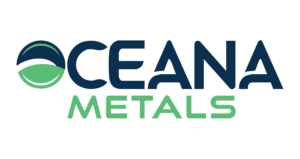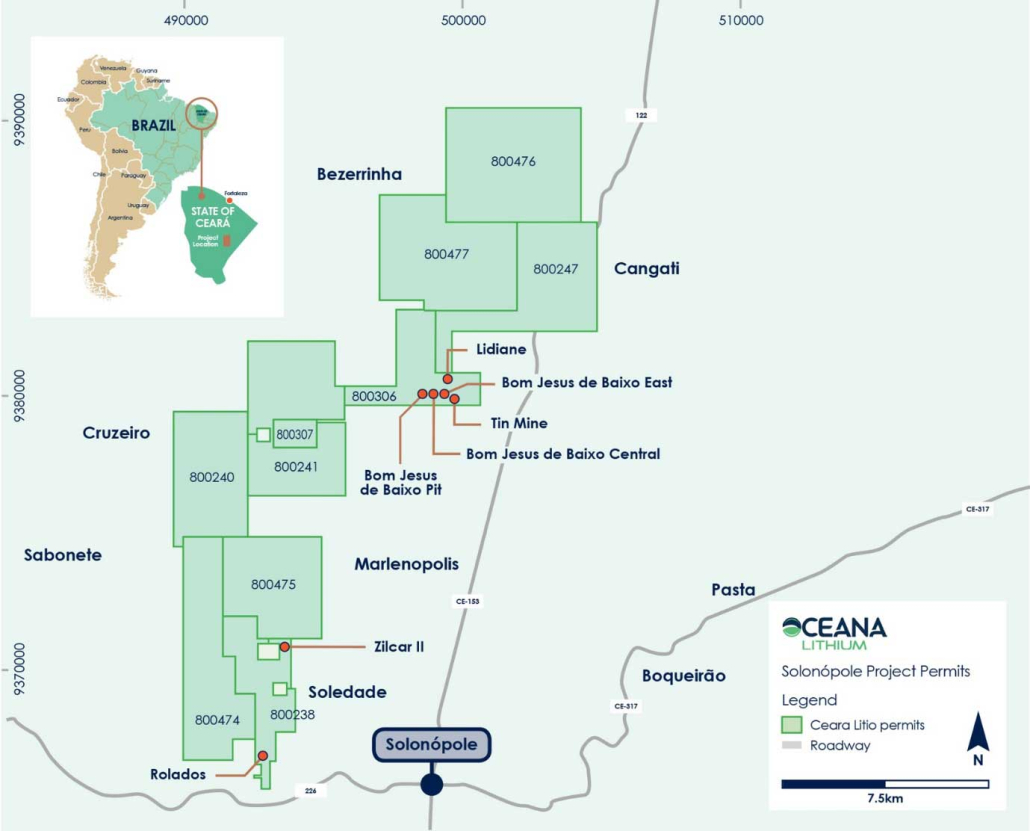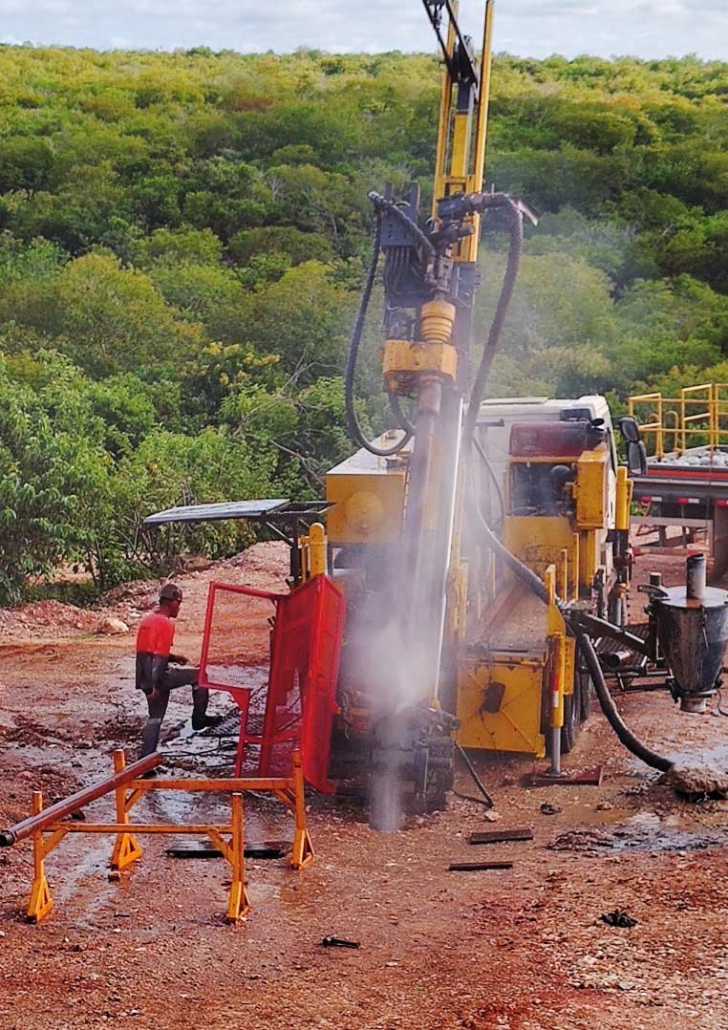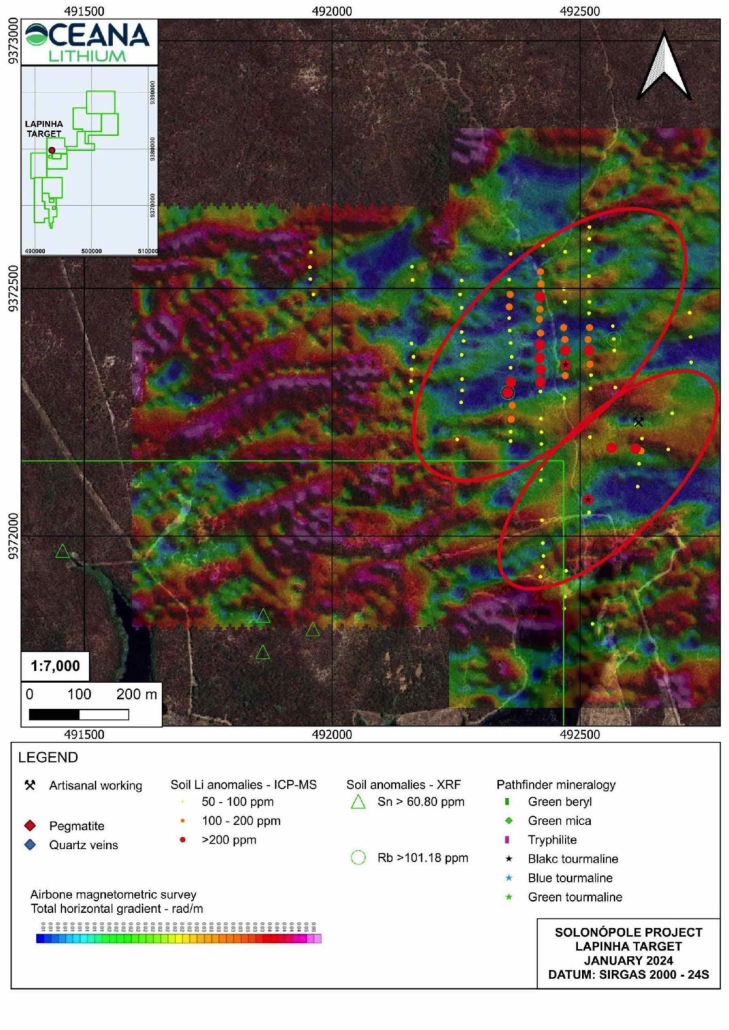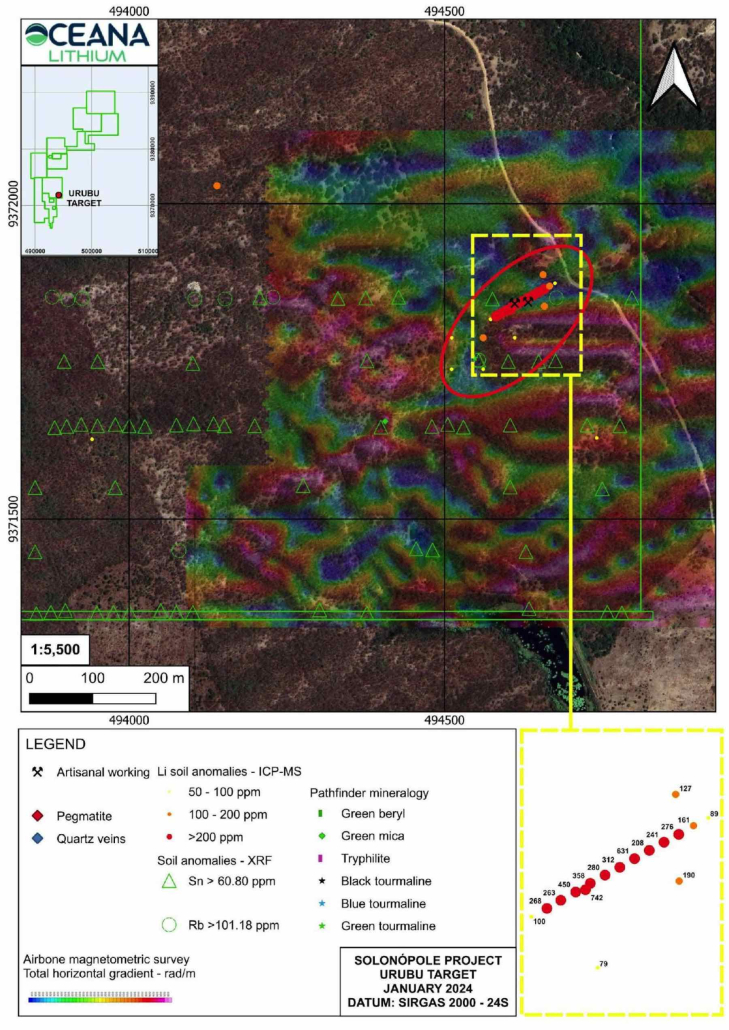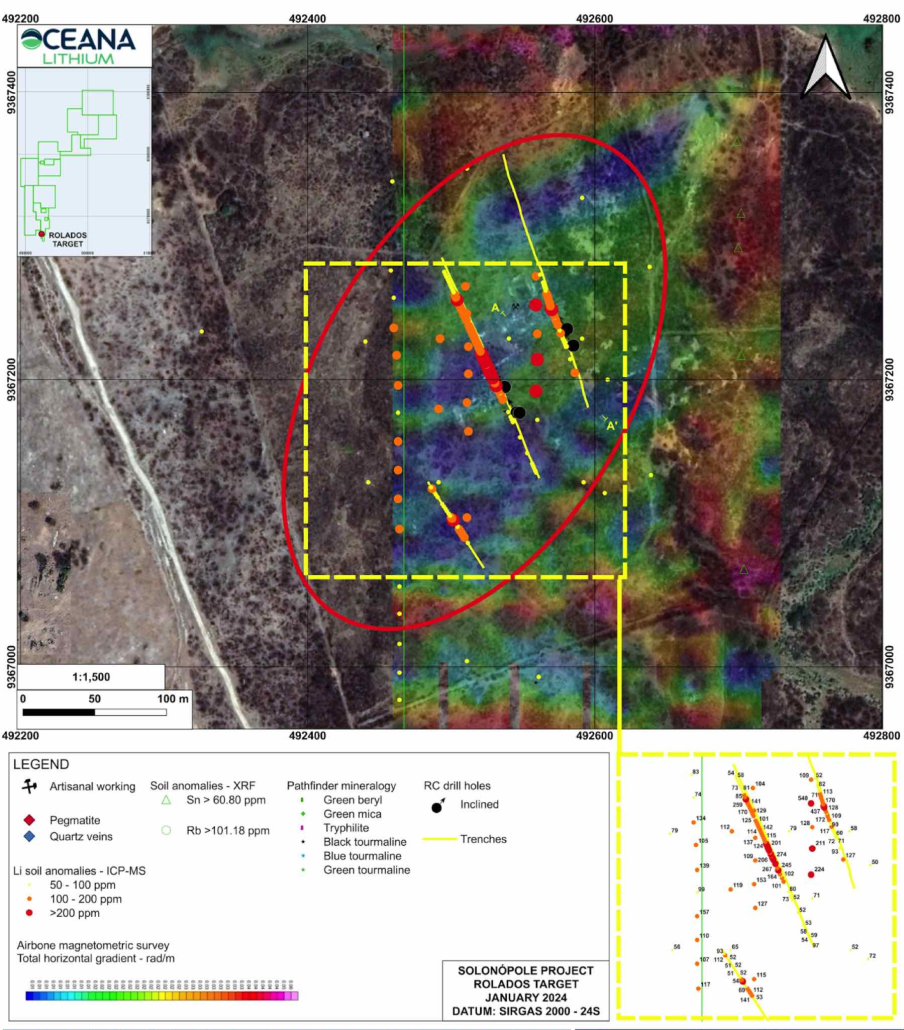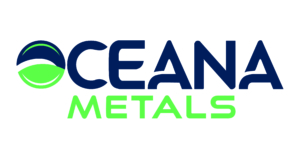Solonopole Lithium Project Brazil
Historic Mines
- Solonópole permits cover historic artisanal mining sites previously mined for lithium, Coltan (tantalum and niobium) and tin
- Over 20 historical small-scale mines have been identified in field exploration. Mining was only undertaken to less than 10 meters vertical depth due to restrictions of hard pegmatite material requiring blasting
Large-scale opportunity, Significantly underexplored
- 10 permits covering 124km2 of highly prospective ground
- Detailed field mapping by Oceana’s Brazilian subsidiary Ceara Litio has identified an approximate 20km outcropping mineralized Pegmatite corridor within the Oceana tenement holding
- Regional geological assessment of the Solonópole Pegmatites was initially completed in 2012 by the Brazilian geological survey department (CPRM). Analytical results (XRD) confirmed Lepidolite, Amblygonite and Spodumene being the main Lithium Minerals
- Outcrop grab samples confirm mineralized pegmatites with anomalous results for lithium, tin, tantalum and niobium
Ideal project location
- Historical lithium mining region in Brazil
- Only 3–4-hour drive on sealed roads to port (Fortaleza)
- The topography, land use and vegetation at Solonópole is well suited for exploration activities
- Arid, sparsely populated farmland, No rain forest
- Northern Brazil provides easy shipping routes to North American and European battery chemical markets
| Mining Tenement | Area (ha) | Date of granting the current Exploration Permit | Original expiry date | Expiry date considering automatic extension* | Times Renewed | Status |
| List of Tenements – OCN IPO Prospectus | ||||||
| 800.238/2016 | 756 | 11/8/2019 | 11/8/2022 | 5/20/2024 | 1 | Expiring** |
| 800.240/2016 | 1246 | 11/8/2019 | 11/8/2022 | 5/20/2024 | 1 | Expiring** |
| 800.241/2016 | 1718 | 11/8/2019 | 11/8/2022 | 5/20/2024 | 1 | Expiring** |
| 800.247/2016 | 1399 | 11/8/2019 | 11/8/2022 | 5/20/2024 | 1 | Expiring** |
| 800.474/2016 | 1416 | 2/22/2022 | 2/22/2025 | N/A | 1 | Active |
| 800.475/2016 | 1180 | 2/22/2022 | 2/22/2025 | N/A | 1 | Active |
| 800.476/2016 | 2000 | 2/22/2022 | 2/22/2025 | N/A | 1 | Active |
| 800.477/2016 | 1762 | 2/22/2022 | 2/22/2025 | N/A | 1 | Active |
| List of Tenements Acquired Since IPO (OCN ASX Announcement 16 January 2023) | ||||||
| 800.306/2020 | 783 | 4/6/2021 | 10/1/2024 | N/A | 0 | Active |
| 800.307/2020 | 145 | 4/6/2021 | 10/1/2024 | N/A | 0 | Active |
| TOTAL Area | 12,406 | Total Active Area: 7,287 ha (6 exploration licences) | ||||
| *In response to the effects of the COVID 19 pandemic, the ANM published some resolutions extending the validity period of some mining rights and, among them, those of the Exploration Permits. | ||||||
| **Expiring: means the second renewal has been denied by ANM Ceará (Regional), pending final decision by ANM in Brasília | ||||||
Ongoing Exploration Work Program & Access
- Qualified and dedicated in-country team to execute on the exploration strategy
- A large-scale infill soil sampling program has commenced in March 2023 over prioritised wider spread 2017 anomalies identified by previous explorer Cougar Metals NL, as well as CPRM mapped pegmatites and artisanal workings. The sampling grids are along 200m spaced lines with 25m sampling stations, aligned north-south in order to cut across all typical pegmatite strike directions in this area. Over 8,300 soil samples have been collected until December 2023
- First pass 2,000m RC drilling program across priority targets completed in August 2023 confirmed presence of Lithium mineralised LCT Pegmatites at shallow depth
- Trial hyperspectral remote sensing survey, and high-resolution magnetics and radiometrics geophysics surveys completed over selected pegmatite and soil grid targets
- An all-weather drying greenhouse has been set up at Oceana’s Solonópole field base, as well as an XRF for the assaying of Li pathfinder elements. Two containers and a warehouse are also on site to provide secure lock-up sample storage
Key Exploration Results
- Anomalous lithium values above 100 ppm (and up to 631 ppm) found in 383 soil samples within several target areas
- Integration and interpretation of these soil sample results with data from geophysics, geological mapping (125 line km), trenching and RC drilling (~2,000m) have further enhanced prospectivity of these targets
- Combined datasets confirm several swarms of pegmatite bodies striking in a NE-SW direction and identify new high priority areas
- Bom Jesus de Baixo (BJdB) Prospect is the most advanced exploration target at the Solonópole Project
- Nira interpreted to be the most prospective new target, with 180 soil samples of >100 ppm Li and as high as 524 ppm Li covering an area of at least 1km2
- Nira also features 17 pegmatite outcrops with average widths of up to 30 meters and strike lengths from 200m to 600m
RC drilling in progress at Solonópole Project, July 2023
High Priority Areas
Bom Jesus de Baixo (“BJdB”) Prospect
The Bom Jesus de Baixo (BJdB) Prospect is the most advanced exploration target at the Solonópole Project. The best scout drilling results from BJdB to date include anomalous lithium grades in three drill holes (NGR-RC-002, NGR-RC-009 and NGR-RC-014):
- BJdB Pit Area: NGR-RC-002, with maximum value over 1m of 0.83% Li2O from 37m to 38m. A lithium-mineralised zone exists from 23m to 38m (15m not true width) averaging 0.34% Li2O, including 6m at 0.50% Li2O. This hole is proximal to where spodumene was previously identified in the BJdB pit.
- BJdB Central Area: NGR-RC-009, with maximum value over 1m of 0.42% Li2O from 16m to 17m. A lithium-mineralised zone exists from 7m to 17m (10m not true width) averaging 0.20% Li2O, including 3m at 0.31% Li2O.
- Tin Mine Area: NGR-RC-014, with maximum value over 1m of 0.45% Li2O from 5m to 6m. A lithium-mineralised zone exists from 4m to 7m (3m not true width) averaging 0.32% Li2O.
Deeper drilling into these unweathered fresh zones is warranted to test whether weathering near surface has resulted in possible leaching of lithium-bearing mineralisation.
As shown in Figure 1, 129 soil samples collected at Bom Jesus de Baixo Prospect have returned anomalous lithium values above 100 ppm (up to 506 ppm).
The area with elevated soil anomalies is approximately 3km2, with 24 soil samples showing lithium values above 200 ppm. Within this anomalous area, Oceana geologists have observed nine artisanal workings and at least 26 pegmatite bodies with average widths of 30m and strike lengths from 150m up to 600m. These pegmatites strike NE-SW and dip to the NW, based on geophysical interpretation and the information gained from the shallow RC drill holes.
Figure 1: Bom Jesus de Baixo Prospect – Integrated Map and Main Results
Figure 2: Nira Target – Integrated Map and Main Results
Nira Target
Oceana geologists have classified Nira as a high priority area. As shown in Figure 2, 180 soil samples collected at Nira have returned anomalous lithium values above 100 ppm (up to 524 ppm). The area with soil anomalies is at least 2km2, with 50 soil samples showing lithium values above 200 ppm.
Within this anomalous area, Oceana geologists have observed at least 17 pegmatite bodies with average width of up to 30m and strike lengths from 200m up to 400m. These bodies are oriented in the NNE-SSW direction on a similar trend to BJdB, located about 3 km to the NE of Nira.
Lapinha Target
Lapinha is evolving as an exploration target. A total of 88 soil samples have been analysed to date, with 27 samples showing lithium anomalous results exceeding 100 ppm. Out of these 27 samples, 15 samples surpass 200 ppm, with the highest anomaly reaching 419 ppm. These anomalies have been interpreted as two parallel structures covering an area of over 1km2 oriented in the NE-SW direction. Oceana geologists have identified at least 11 pegmatite bodies with dimensions ranging from 225 to 425 meters length and 10 to 25 meters width, oriented in the ENE-WSW direction, as indicated by soil geochemistry, geophysics and geological mapping data.
Figure 3: Lapinha Target – Integrated Map and Main Results
Figure 4: Urubu Target – Integrated Map and Main Results
Urubu Target
A total of 22 soil samples were collected at Urubu, of which 17 are located within 5m of the main pegmatite body which strikes in a NE-SW direction. Out of these 17 samples, 14 show lithium anomalous results greater than 100 ppm, and 11 of them exceed 200 ppm. Notably, five samples have lithium values ranging from 300 ppm to 742 ppm. The main body outcrops over a length of 160m, with a width of approximately 20m, oriented in the NE-SW direction.
Zilcar II Target
The Zilcar II target is located within the Soledade West Prospect (Permit 800238) and consists of an old pit from which Li-bearing grab-samples were taken by previous tenement owner Cougar Metals Ltd in 2017-18. Amblygonite samples returned up to 9.29% Li2O and 17.32% P (refer to ASX Announcement dated 7 August 2023). A total of 3 drill holes (212m total) and two trenches (SOL-TR-004 and SOL-TR-005) were completed across the old pit area situated ~150m to the north-west of the soil-grid. The best drill hole intercepts were from SOL-RC-008, with maximum value over 1m of 0.95% Li2O from 52m to 53m.
A total of 17 soil samples (out of 48 soil samples from Zilcar II) returned lithium anomalies above 100 ppm (up to 189 ppm). There are at least 11 pegmatite bodies with 150-250m in length and 10-20m in thickness striking ENE-WSW.
Figure 5: Zilcar II Target – Integrated Map and Main Results
Figure 6: Rolados Target – Integrated Map and Main Results
Rolados Target
At the Rolados Target, three trenches were completed on a portion of the anomaly (SOL-TR-001 to SOL-TR-003), and several samples have returned lithium results above 100 ppm. Final results from shallow scout RC drilling also returned anomalous lithium values at three drill holes (SOL-RC-001, SOL-RC-002 and SOL-RC-005). The best intercepts include:
- Rolados: SOL-RC-001, with anomalous lithium values from 43m to 44m (1m not true width) averaging 0.26% Li2O. This hole is proximal to mapped pegmatites and trench samples with lithium values above 200 ppm.
- Rolados: SOL-RC-002, with anomalous lithium values from 11m to 12m (1m not true width) averaging 0.28% Li2O. This hole is also less than 50m to mapped pegmatites and trench samples with lithium values above 200 ppm.
- Rolados: SOL-RC-005, with anomalous lithium values from 44m to 47m (3m not true width) averaging 0.23% Li2O, including 1m at 0.29% Li2O. Located only a few meters away from SOL-RC-002.
A total of 21 soil samples (out of 38 soil samples collected at Rolados) presented lithium anomalies exceeding 100 pm (up to 524 ppm). There are at least 8 pegmatite bodies, ranging from 70 to 160m in strike length and 5 to 10m in thickness striking ENE-WSW.
